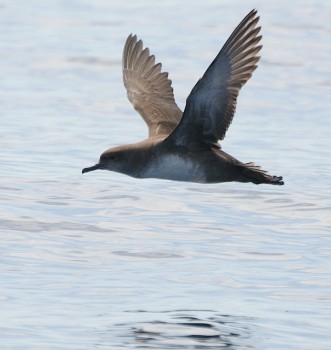Jorge Pereira (MARE – Marine and Environmental Sciences Centre, Departamento de Ciências da Vida, Universidade de Coimbra, Portugal) and colleagues have published in the journal Ocean and Coastal Management on choosing marine protected areas (MPAs) off Portugal via at-sea surveys of seabirds, including the ACAP-listed and globally Critically Endangered Balearic Shearwater Puffinus mauretanicus.
The paper’s abstract follows:
“Marine Protected Areas (MPAs) have been established across all marine environments, though their coherence and effectiveness in protecting umbrella species remains unclear. We used a multi-model ensemble forecasting approach, on 8 years of at-sea censuses of 30 seabird species to identify candidate MPAs in the Portuguese coast, prioritizing important areas for their conservation based on their occurrence and distribution. We overlapped the outputs generated by the Ensemble Ecological Niche Models (EENMs) with layers representing important environmental stressors (fishing intensity, ship density and oil pollution risk), and calculated loss in conservation value using them as cost layers. Three key marine areas were identified along the Portuguese coast: For breeders, there was a key marine area encompassing the Tagus and Sado estuaries and Berlengas archipelago; for nonbreeders and migratory species two important areas were identified in the Northern and Southern coast. The key marine area identified in the Northern coast is characterized by high productivity and biodiversity, and can be affected by oil pollution from the refineries and the intensive ship traffic in this area. Also, the area identified in the Southern coast of Portugal for migratory seabirds overlaps extensively with areas of high fishing activity. Our results show that the Important Bird and Biodiversity Areas (IBAs) established along the Portuguese coast protect more than a third of the areas that we prioritized for breeding species and the official MPAs near 65% of the same areas. In contrast, current IBAs and national legislation protect less than 4% of the coastal areas that we prioritize for non-breeding species in this study. Our study, combining multi-species distribution with environmental constraints induced by human activities, allowed us to assess the coherence of the Portuguese marine planning and identify candidate areas to join the Portuguese network of marine protected areas. Our results, employing data from annual at-sea surveys together with the human stressors known to affect the Portuguese coast, proved to be an extremely useful strategy to identify spatial conservation areas along the Portuguese coast as well as to access the adequacy and consistency of those areas. Despite the constraints of this demanding approach, we are confident that our study provides a reliable strategy to inform marine conservation efforts and management planning in similar coastal environments elsewhere, characterized by strong coastal upwelling movements.”

Balearic Shearwater at sea
With thanks to Susan Mvungi, Niven Librarian, FitzPatrick Institute, University of Cape Town.
Reference:
Pereira, J.M., Krüger, L., Oliveira, N., Meirinho, A., Silva, A., Ramos, J.A. & Paiva, V.H. 2017. Using a multi-model ensemble forecasting approach to identify key marine protected areas for seabirds in the Portuguese coast. Ocean and Coastal Management 153: 98-107.
John Cooper, ACAP Information Officer, 12 January 2018

 English
English  Français
Français  Español
Español